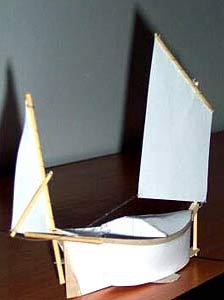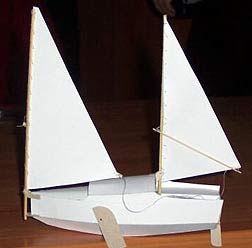Ugly Ducklings
Last month in one of the Polish online yachting magazines,
I found an article by designer Krzysztof Mnich, presenting his
new designs. The title was “Ugly Ducklings: PHIL and JIM”.
Ugly ducklings? Let me think… it comes from Hans Christian
Andersen tales and describes any creature being ugly now but
becoming surprisingly beautiful in the future, becoming a swan.
Phil and Jim? I’m sure I know those names!
Let me summarize the introduction of this presentation:
“People use to think that a yacht should be a piece of
“beauty”, with fine shapes and plenty of details
and accessories. However in the rich United States there has
appeared a kind of “social movement” for building
simple, logical, not obviously beautiful, but surely cheap,
boats, which are possible to build at home by overworked Americans.
People build these boats, navigate on them and, being proud
of them, announce it on internet. On Duckworks, for example,
never mind that the result sometime reminds one of a bed with
a narrow bow. It can be surprising to discover that the way
of tourism supported by Duckworks is just as interesting as
any other. The truth, as one of Poland’s yacht designers
Stefan Ekner said, is that our lakes do look fine either from
a $500 or $50000 yacht. Being fascinated with the simplicity,
logic and ugliness of those boats, Krzysztof Mnich decided to
design his own two versions. He was looking for designs that
were unpretentious, uncompromising, cheap, but also with personality.
And now let me quote the introduction of my own article from
the January/February 2004 issue of REJS, another Polish yacht
magazine, presenting the Campjon project (click photo below):

“Parallel to luxury yachting and mass production
of boats for average users, in many countries a movement is
growing for building very cheap but conceptually highly advanced
plywood boats. The top rule here is to build as cheaply as possible,
and sometimes to keep out of common ways of boat building and
yachting as far as possible. Builders support each other using
internet magazines and discussion boards. I’ve joined
this movement in looking for a power boat able to navigate the
Wisla river near Warsaw and beyond.”
Notice that two independent people have the same perception
of the phenomenon . We both called it “the movement”.
It means that discussed activity and overall reception is truly
spontaneous, strong, and able to be self-organized in a good
way. I don’t know about your colleagues, but I feel like
a member of an independent movement when other sailors ask me
(while looking at my Campjon), “Oh well, then it floats?”
I know it, and I’m not alone –there are hundreds
of us all over the world. Ask my friend Luke from Queensland,
Australia, or my friend Willie from Illinois, USA, or any other
one.
The amazing point is that one Polish author is fascinated with
“ugliness” of those boats, and the other one (it’s
me), is fascinated with their minimal aesthetics, which became
a classic style of modern arts recently. But the matter concerns
more than recent style. Robert Bruce Duncan, author of excellent
book “Cutwater Speedboats and Launches from the Golden
Age of Boating” describing several classic runaboats and
motor launches built between 1900 and WWII, still in use in
Canada and the U.S. In the chapter describing the motor launch
Maxine, built in 1923, he states that the boat belongs to an
uncommon line of boats, which, never mind their place of birth,
United States, Canada or Europe, look the same. Duncan comments
that the design presents a perfect balance between form and
function. Before reading his words, I was thinking: “Hey,
I saw a boat like that at Jim Michalak’s online newsletter
before… was it the AF4 by Bayard Cook? That’s it,
surely a bit smaller”. And then Duncan mentioned this
about medieval gothic church builders: they built cathedrals
that looked the same all over the mid age world, because they
were searching for universal perfection, not for personal fame.
Great comparision.

Well, let’s take a look at PHIL and JIM
now. As the author says, PHIL (click the photo above) is is
a little 4.5 m (14.7 ft) flat bottomed dory inspired by New
Foundland fishing boats. The author recommends this type of
hull as phenomenally simple and robust. He writes that the hull
is similar to the hull of Centennial in which Alfred
Johnson crossed Atlantic in 1876. The only difference is
a vertical stem required by this sort of rig. The building method
is “taped-seam”, the material is 8-10 mm plywood.
The hull has a horizontal steel plate mounted to the bottom
working either as a ballast or as strength factor. The rig is
directly taken from a Bolger designed ketch: lug main and common
sprit-boomed, leg-o'-mutton mizzen. Sail area is 12 m sq. (129
sq ft). The author intended PHIL to be a bay and lagoon sailer.

JIM (click the photo above) is destined for our
Mazury Lakes, so there is no need to battle against big waves,
but it’s useful to have small draft and roomy interior.
The author says it’s an attribute typical for Jim
Michalak designs. Michalak, inspired with Bolger’s
boats, has created his own style, simplifying a boat’s
shapes where possible, but not forgetting the hydrodynamics.
Mnich’s JIM is much the same. The hull is 7 m (22,9 ft
) long, and has a wide stern transom. The ballast, as in PHIL’s
case, is a horizontal steel plate mounted to the bottom. It
makes sure the boat will right itself even from 90 degrees of
heel. The cabin and deck design depend on the user’s needs.
There is the option of building a short cabin and lower bow,
or a long cabin with a higher bow. The interior is roomy enough
for a 5 person family. The rig is cat-ketch (favorite of Duckwork’s
type designers) with sprit main and mizzen : sail area is 21
meters sq. (226 ft sq.). The author recommends JIM as not especially
beautiful, but as a comfortable, quite big and cheap yacht,
supposed to float pretty well on quiet waters.
Wojtek Baginski, Warsaw, Poland

